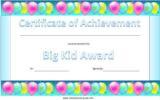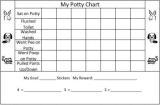Potty Training Tips for Boys and Girls
I can't wait to help you learn the best potty training tips for toddlers and kids with autism with a free step by step plan for giving you all of the necessary information you need to get your child trained and throw those diapers away for good! From printable reward charts, certificates for children, and coloring pages, you couldn’t have more tools at your fingertips. Teaching children to use the toilet can be frustrating, but it doesn’t have to be. Whether you have a kiddo with autism or toddler with ADHD, just read through each page and follow the program one step at a time along with other recommendations. Getting them fully trained in a short period of time is possible and can actually be fun and rewarding too!
When to start
Knowing the right age to get started can be half the battle in getting your little one trained. They should not only have the readiness signs, but also be able to perform the necessary behaviors needed to independently use the toilet. This may include being able to stay dry for longer periods of time or attempting to constantly remove a diaper after having a bowel movement or getting wet. You can learn more about these signs by clicking the link above.
How to Start
Now that you know when to start, it's important to know how to start. You want to know what behaviors to work on and how to help them acquire the necessary skills. Learning to sit on the toilet increasing up to 5 consecutive minutes may be easy for some kids, but for others this can be difficult. In addition, being able to communicate the need to go, learning how to wash hands and pulling pants up and down independently would also be things to work on prior to starting. You can learn more potty training tips on how to start by clicking the link above.
Tools and Resources
Prior to starting the process, make sure you have the tools you need to make day one run smoothly. This provides a great list of things to aid in learning and keep the focus on getting trained. One of the best potty training tips I received was to make everything all about things related to the toilet and eliminate most toys unless they are about using the bathroom or used as a reward for going. This is why I created a list of things to get, along with free coloring pages and a big kid award certificate you can download by clicking the link above.
Use a Reward Chart
For many children a sticker chart helps provide motivation for using the toilet and makes the process much more fun! Parents of kids with autism symptoms may also provide these to be used during ABA sessions as part of discrete trials for helping their child develop associated behaviors. They can add stickers, stars or color each spot as they demonstrate the skills, then when it's full you can give them a larger reward. Saving their favorite toy for the bathroom to be given along with the sticker when they demonstrate skills is the best way to use them.
Free Charts to Download
Potty Training in Just Three Days – Day 1
Finally, once your child is able to do all of the prerequisite skills, it's time to get officially started and get rid of those diapers! Start with Day 1 when you know you'll be able to be home all day without any distractions. While some parents assume that it may take months of learning to use the bathroom instead of a diaper, if you can make the time, this step by step process provides potty training tips that will help a child learn at a much more rapid pace that I personally used to train all three of my own children. Once we started, they never wore diapers again.
Day 2
Now, it's time to move on to day 2. At this point, you will be in the maintenance phase. It’s important to continue following the potty training tips outlined for this part of the process to ensure your little one continues learning and applying the skills needed for independent toileting. You'll focus on fading prompts and scheduled access by having them spontaneously going or asking to go on their own. It's an important part of the process to avoid long term prompt dependency and accidents when you may "forget" to sit them on the toilet.
Potty Training Tips for Public Places – Day 3
Finally, on the third day, you will want to follow the link above to find potty training tips that focus on being able to go into the community and use public restrooms. This can be a process by itself. It requires practicing when you don't actually have something you need to do, such as gathering a long list of groceries. Quick trips to common places is what you'll be doing as you want to be sure they are comfortable asking and going on a strange toilet. Once you are ready for this part of the process you can click on the link above.
Responding to Accidents
Knowing how to respond to accidents is so important so that you don't see any regression. Scolding or any form of punishment for accidents other than practice trials could derail your progress and make it more likely to have to go back to the beginning of the process. You want to increase your child's ability to control his/her bladder and bowels. All children will have accidents when first getting toilet trained, so you must first recognize that this is an essential part of the learning process and know how to respond without causing any type of regression. For more tips on this you can click the link above.
Dealing with Regression
If you do find yourself in a situation with regression, don't despair! It is not uncommon for some children to show regression after demonstrating that they are trained. It doesn't always mean that something is wrong and can often be a quick fix. You can learn more potty training tips with causes of this and ways to respond to symptoms of regression by clicking the link above.
Bowel Movements
This is one of the most commonly reported problems I have found for parents, but it doesn’t have to be. In fact, I personally came up with a special trick that works like a charm to get kids having bowel movements on the toilet with a little bit of effort and patience on your part. You can learn the common reasons for children refusing to use the toilet for bowel movements along with great ideas and tips for solving this problem by clicking the link above. They'll even work for children with autism!
If you made it this far, hopefully you have successfully gotten your little one out of diapers and fully trained! Congratulations!!


